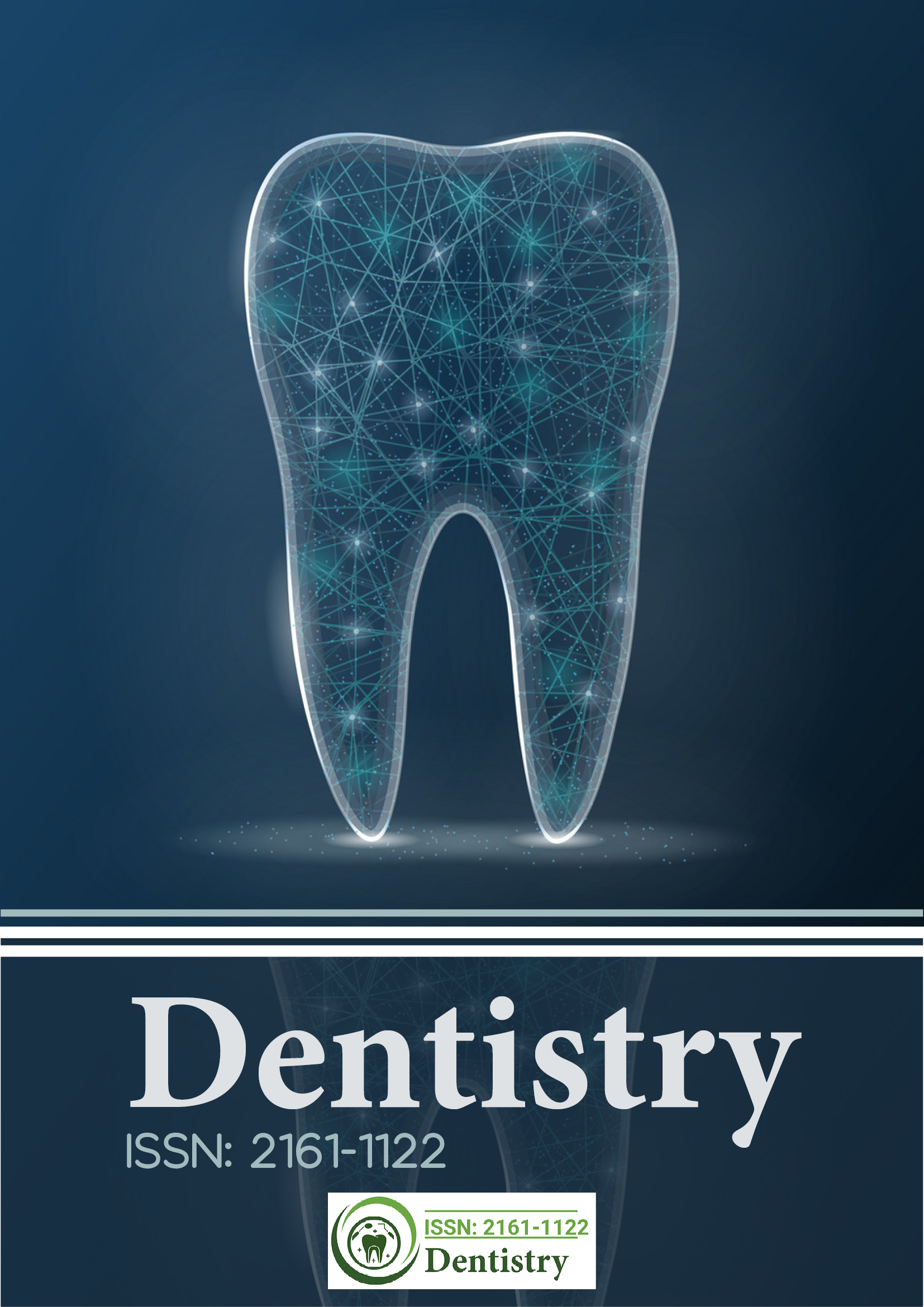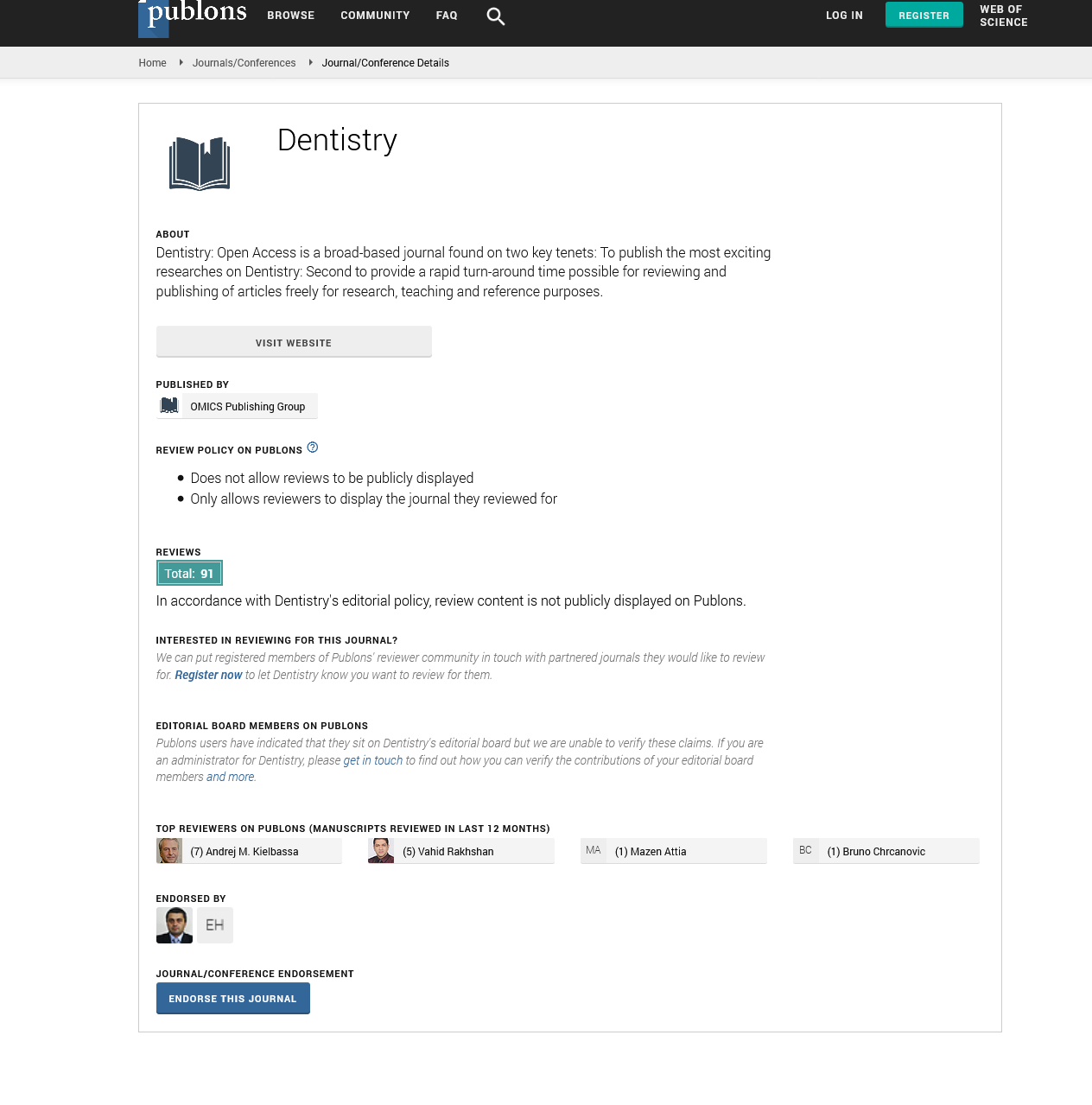Citations : 2345
Dentistry received 2345 citations as per Google Scholar report
Indexed In
- Genamics JournalSeek
- JournalTOCs
- CiteFactor
- Ulrich's Periodicals Directory
- RefSeek
- Hamdard University
- EBSCO A-Z
- Directory of Abstract Indexing for Journals
- OCLC- WorldCat
- Publons
- Geneva Foundation for Medical Education and Research
- Euro Pub
- Google Scholar
Useful Links
Share This Page
Journal Flyer

Open Access Journals
- Agri and Aquaculture
- Biochemistry
- Bioinformatics & Systems Biology
- Business & Management
- Chemistry
- Clinical Sciences
- Engineering
- Food & Nutrition
- General Science
- Genetics & Molecular Biology
- Immunology & Microbiology
- Medical Sciences
- Neuroscience & Psychology
- Nursing & Health Care
- Pharmaceutical Sciences
Perspective - (2025) Volume 15, Issue 2
Dental Pulp Stem Cell Approaches for Oral Tissue Regeneration
Elisabeth Cendes*Received: 26-May-2025, Manuscript No. DCR-25-29702; Editor assigned: 28-May-2025, Pre QC No. DCR-25-29702 (PQ); Reviewed: 11-Jun-2025, QC No. DCR-25-29702; Revised: 18-Jun-2025, Manuscript No. DCR-25-29702 (R); Published: 25-Jun-2025, DOI: 10.35248/2161-1122.25.15.728
Description
Dental Pulp Stem Cells (DPSCs) are a unique population of mesenchymal stem cells with self-renewal and multipotent differentiation capabilities. Advances in 3D organoid technology have enabled the development of complex tissue models that replicate aspects of native oral and maxillofacial structures. This review examines the regenerative applications of 3D organoids derived from DPSCs, exploring their potential in tissue engineering, disease modeling and translational therapies. Methods for organoid construction, differentiation and functional assessment are discussed alongside current challenges and future directions in oral and maxillofacial regeneration.
Tissue regeneration in the oral and maxillofacial region remains a significant challenge due to the complex architecture and functional requirements of craniofacial tissues. Dental pulp stem cells, isolated from the pulp tissue of teeth, offer an accessible source of multipotent stem cells capable of differentiating into odontogenic, osteogenic, chondrogenic and neurogenic lineages. Recent developments in Three-Dimensional (3D) organoid culture techniques have enabled the creation of in vitro models that more accurately reproduce tissue organization and cellular interactions compared to traditional two-dimensional cultures. 3D organoids derived from DPSCs provide a platform for regenerative applications, offering potential strategies for reconstructing oral and maxillofacial tissues, modeling disease and screening therapeutics.
3D organoid technology
Organoids are self-organizing, multicellular structures derived from stem cells that mimic key features of native tissues. Compared to conventional 2D cultures, 3D organoids provide a more physiologically relevant microenvironment, allowing cell-cell and cell-matrix interactions that influence differentiation, tissue organization and function. Methods for generating organoids include embedding cells in extracellular matrix scaffolds, suspension culture systems and microfluidic devices. The use of DPSCs in 3D culture systems enables the formation of organoids capable of generating mineralized matrices, vascular-like structures and neural networks, which are essential for functional tissue regeneration in the craniofacial region.
Regenerative applications in oral tissues
DPSC-derived organoids have been investigated for regeneration of dental tissues, including dentin and pulp-like structures. Studies demonstrate that organoids can differentiate into odontoblast-like cells and produce extracellular matrix components, contributing to tissue repair in vitro and in vivo. These organoids offer the potential to replace damaged pulp tissue, restore tooth vitality and integrate with host vasculature. Furthermore, DPSC organoids provide a model to study tooth development, cellular signaling and biomaterial interactions, facilitating the design of regenerative strategies tailored to clinical needs.
Bone and craniofacial tissue regeneration
Beyond dental tissues, DPSC-derived organoids show promise for regenerating craniofacial bone. Osteogenic differentiation within organoids leads to mineralized tissue formation, which can be applied to defects in the jaw, alveolar ridge and other facial bones. When combined with biomaterial scaffolds, these organoids support structural integrity, angiogenesis and osteointegration. Preclinical studies indicate that transplantation of DPSC organoids into bone defects promotes repair and functional recovery, demonstrating their potential as a cell-based regenerative therapy for oral and maxillofacial reconstruction.
Vascularization and neural integration
Effective regeneration in the craniofacial region requires the development of vascular and neural networks. DPSC-derived organoids have been shown to secrete angiogenic factors, support endothelial cell migration and form vascular-like channels within 3D constructs. Neural differentiation within organoids enables the formation of neuron-like cells and networks, which may enhance sensory and functional restoration. Integration of vascular and neural elements in organoids is essential to achieve long-term survival and functionality of regenerated tissues, particularly in complex oral and maxillofacial defects.
Disease modeling and drug testing
3D organoids derived from DPSCs provide a platform for modeling oral and craniofacial diseases, including pulpitis, periodontitis and bone disorders. These organoids allow investigation of disease mechanisms, cellular responses and interactions with microbial communities in a controlled environment. Additionally, organoids can be used for high-throughput drug screening, enabling evaluation of regenerative compounds, biomaterials and pharmacological agents. This approach facilitates preclinical testing while reducing reliance on animal models and improving translational relevance.
DPSC-derived 3D organoids offer a versatile platform for regenerative applications in the oral and maxillofacial region. Their ability to differentiate into multiple cell types, form organized tissue structures and support vascular and neural integration positions them as a valuable tool for tissue engineering, disease modeling and therapeutic development. Despite current challenges in standardization, scaling and clinical translation, ongoing research continues to advance the field, providing potential solutions for reconstructive and regenerative therapies in complex craniofacial defects. Continued exploration of DPSC organoids will contribute to the development of effective, functional and clinically applicable regenerative strategies.
Citation: Cendes E (2025). Dental Pulp Stem Cell Approaches for Oral Tissue Regeneration. J Dentistry. 15:728.
Copyright: © 2025 Cendes E. This is an open-access article distributed under the terms of the Creative Commons Attribution License, which permits unrestricted use, distribution, and reproduction in any medium, provided the original author and source are credited.

